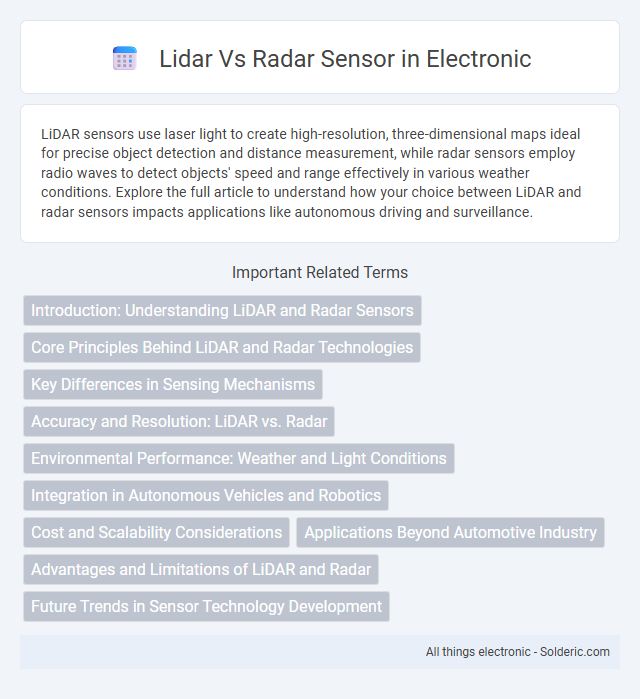LiDAR sensors use laser light to create high-resolution, three-dimensional maps ideal for precise object detection and distance measurement, while radar sensors employ radio waves to detect objects' speed and range effectively in various weather conditions. Explore the full article to understand how your choice between LiDAR and radar sensors impacts applications like autonomous driving and surveillance.
Comparison Table
| Feature | Lidar Sensor | Radar Sensor |
|---|---|---|
| Technology | Light Detection and Ranging (laser pulses) | Radio Detection and Ranging (radio waves) |
| Range | Short to medium (up to 200 meters) | Long (up to several kilometers) |
| Resolution | High spatial resolution, detailed 3D mapping | Lower resolution, better at detecting object speed |
| Weather Performance | Affected by fog, rain, dust | Works well in fog, rain, and dust |
| Cost | Higher cost | Lower cost |
| Common Applications | Autonomous vehicles, robotics, mapping | Automotive radar, aviation, maritime |
Introduction: Understanding LiDAR and Radar Sensors
LiDAR sensors utilize laser pulses to create high-resolution, three-dimensional maps by measuring the time it takes for light to reflect off objects, making them ideal for detailed spatial analysis in autonomous vehicles and robotics. Radar sensors emit radio waves to detect objects and measure their distance, speed, and direction, performing reliably in adverse weather conditions such as fog, rain, or dust. LiDAR offers superior accuracy and resolution for close-range object detection, while radar excels in long-range detection and operates effectively under challenging environmental scenarios.
Core Principles Behind LiDAR and Radar Technologies
LiDAR sensors utilize laser light pulses to measure distances by calculating the time it takes for the light to reflect back from objects, enabling high-resolution 3D mapping. Radar sensors emit radio waves that bounce off objects and return signals to determine speed and distance, excelling in various weather conditions due to longer wavelengths. The core principle of LiDAR lies in precise light-based distance measurement, while Radar relies on radio wave reflection for object detection and velocity assessment.
Key Differences in Sensing Mechanisms
Lidar sensors use laser pulses to measure distances by calculating the time it takes for light to reflect back from objects, providing high-resolution 3D maps with precise spatial accuracy. Radar sensors emit radio waves that bounce off objects and measure the returned signal's time and frequency shift, offering robust performance in various weather conditions but with lower resolution. The fundamental difference lies in lidar's use of light detection for fine details versus radar's reliance on radio frequency for broader range and durability.
Accuracy and Resolution: LiDAR vs. Radar
LiDAR sensors offer superior accuracy and higher resolution than radar by emitting laser pulses that create detailed 3D maps with precise distance measurements up to a few centimeters. Radar sensors, utilizing radio waves, provide longer range detection but with lower spatial resolution, often limited to meter-level accuracy, making them less effective for fine object differentiation. This makes LiDAR ideal for applications requiring precise environmental mapping, while radar excels in robust detection in adverse weather conditions.
Environmental Performance: Weather and Light Conditions
LiDAR sensors excel in providing high-resolution, detailed 3D maps but their performance significantly degrades in adverse weather conditions such as heavy rain, fog, or snow due to light scattering. Radar sensors maintain reliable detection and ranging capabilities under various weather conditions, including rain, fog, and dust, as they use radio waves less affected by environmental factors. While LiDAR offers superior spatial accuracy and object classification in clear conditions, radar ensures consistent performance across diverse lighting and weather scenarios, making it essential for all-weather autonomous navigation.
Integration in Autonomous Vehicles and Robotics
Lidar sensors provide high-resolution 3D mapping essential for precise object detection and navigation in autonomous vehicles and robotics, enabling advanced environmental perception. Radar sensors excel in detecting objects at longer ranges and perform reliably in adverse weather conditions, supporting safety and obstacle avoidance systems. Your autonomous system benefits from integrating both lidar and radar to leverage complementary strengths, enhancing robustness and situational awareness.
Cost and Scalability Considerations
Lidar sensors typically cost significantly more than radar sensors due to their complex components like lasers and photodetectors, making radar a more budget-friendly option for large-scale deployments. Radar's affordability and simpler manufacturing process enable easier scalability across automotive and industrial applications. Your choice depends on whether high-resolution data justifies the higher investment in lidar or if the cost-efficient, scalable performance of radar better suits your project needs.
Applications Beyond Automotive Industry
Lidar sensors provide precise 3D mapping capabilities crucial for applications in agriculture, forestry, and archeology, enabling accurate terrain analysis and vegetation monitoring. Radar sensors excel in maritime navigation and aviation for obstacle detection and weather monitoring, offering reliable performance in adverse environmental conditions. Both technologies are integral to robotics and security systems, where lidar ensures detailed environment scanning and radar supports long-range object detection.
Advantages and Limitations of LiDAR and Radar
LiDAR sensors deliver high-resolution 3D mapping and precise distance measurement, excelling in detailed object detection and environmental modeling, but their performance can be hindered by adverse weather conditions like heavy rain or fog. Radar sensors perform reliably in various weather scenarios, offering long-range detection and velocity measurement, yet they provide lower spatial resolution and less detailed imagery compared to LiDAR. Your choice depends on application needs: LiDAR suits environments demanding fine spatial detail while Radar is preferable for robust performance under poor visibility.
Future Trends in Sensor Technology Development
Lidar sensors are advancing with higher resolution and longer range capabilities, leveraging solid-state technology for increased durability and cost-efficiency in autonomous vehicles. Radar sensors are evolving with enhanced signal processing algorithms and integration of multiple frequency bands to improve object detection accuracy in various weather conditions. Future sensor technology development emphasizes sensor fusion, combining lidar, radar, and camera data to create robust perception systems for next-generation driver assistance and autonomous systems.
lidar vs radar sensor Infographic

 solderic.com
solderic.com